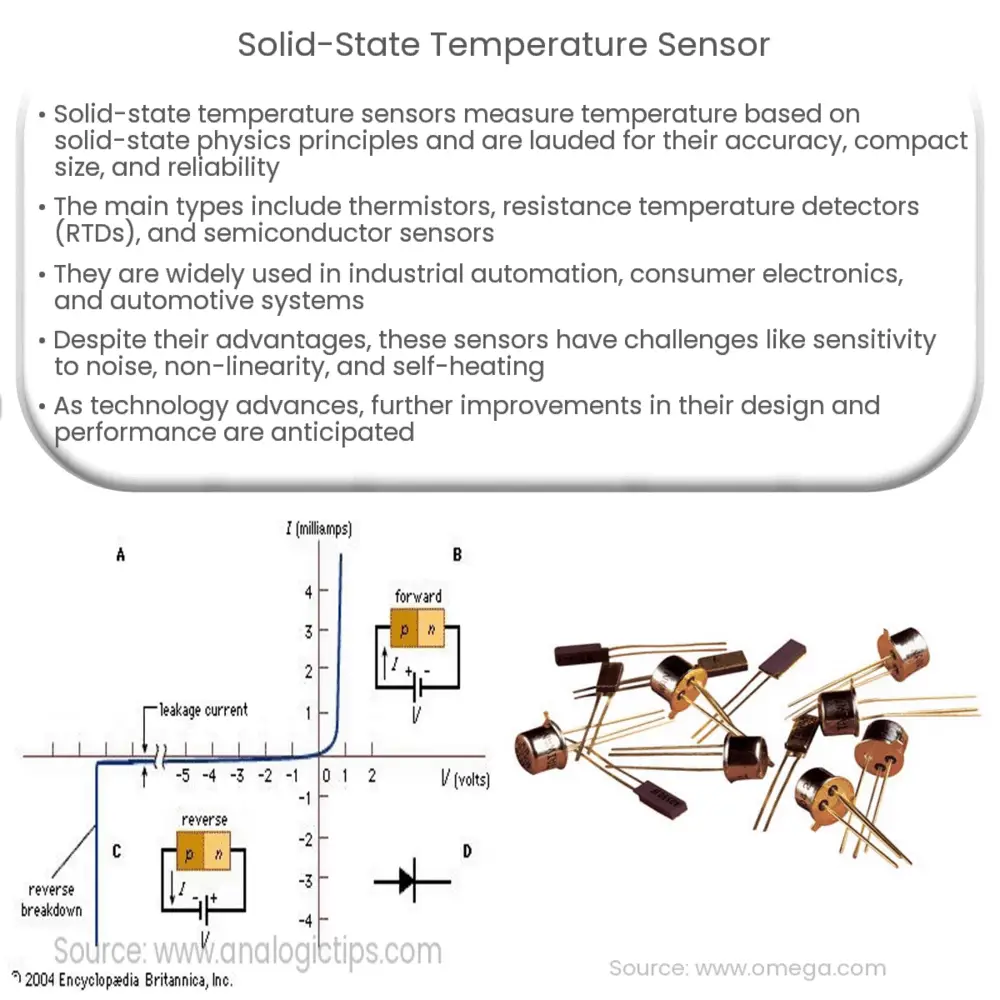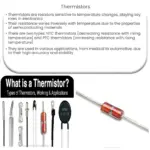Explore the principles, types, applications, and challenges of solid-state temperature sensors in our detailed guide.

Solid-State Temperature Sensors: An Overview
Solid-state temperature sensors are a category of devices designed to measure temperature using the principles of solid-state physics. They are commonly used in a broad spectrum of applications due to their reliability, accuracy, and compact size.
Types of Solid-State Temperature Sensors
- Thermistors: These are temperature-sensitive resistors that display a change in electrical resistance with varying temperature. They are typically very accurate, but their use is limited to a relatively narrow temperature range.
- Resistance Temperature Detectors (RTDs): RTDs use the principle that the electrical resistance of certain metals increases linearly with temperature. They offer excellent precision and repeatability, particularly over a wide temperature range.
- Semiconductor Sensors: Also known as IC temperature sensors, they use the temperature-dependent properties of semiconductor materials to measure temperature. These sensors offer a wide operating range, good linearity, and typically come with digital outputs.
Working Principles of Solid-State Temperature Sensors
The working principles of these sensors can be attributed to the temperature-dependent properties of solid-state materials. For instance, in thermistors and RTDs, the resistance of the sensor material changes with temperature. This change in resistance can be measured and converted into a temperature reading.
On the other hand, semiconductor temperature sensors leverage the fact that the voltage across a diode or the base-emitter junction of a transistor is temperature-dependent. By precisely measuring this voltage, the temperature can be inferred. These sensors are often integrated into microcontroller or microprocessor chips, providing a digital output that is easy to interface with other digital systems.
Applications of Solid-State Temperature Sensors
Solid-state temperature sensors find usage in a multitude of applications, including:
- Industrial Automation: They are used in control systems to monitor and regulate process temperatures. This helps to maintain optimal operating conditions and safeguards against equipment failure due to overheating or freezing.
- Consumer Electronics: These sensors are embedded in devices like smartphones, laptops, and gaming consoles to monitor the device temperature and protect against thermal damage.
- Automotive Systems: In vehicles, they monitor engine temperature, cabin temperature, and other critical parameters.
Despite their widespread use, solid-state temperature sensors have certain limitations and challenges, which we will explore in the next section of this article.
Limitations and Challenges of Solid-State Temperature Sensors
While solid-state temperature sensors offer numerous advantages, they also present certain challenges and limitations.
- Sensitivity to Noise: Solid-state sensors, especially semiconductor-based ones, can be highly sensitive to electrical noise. This can cause inaccuracies in temperature readings if not properly mitigated.
- Non-Linearity: Some types of sensors, such as thermistors, have a non-linear response to temperature changes. This necessitates complex calibration and compensation methods to achieve accurate readings over a wide temperature range.
- Self-Heating: In situations where the sensor draws a significant amount of current, it can heat up, affecting its own temperature reading. This phenomenon, known as self-heating, can lead to inaccuracies if not taken into account.
Conclusion
In conclusion, solid-state temperature sensors are an indispensable part of many modern technologies. Their versatility, accuracy, and compact size make them suitable for a wide range of applications, from industrial automation to consumer electronics and automotive systems. However, their usage also comes with certain limitations, such as sensitivity to noise, non-linearity, and self-heating, which must be considered during system design and implementation.
Despite these challenges, the field of solid-state temperature sensing continues to advance, driven by ongoing research and development efforts. As new materials and technologies emerge, it is likely that we will see even more accurate, reliable, and cost-effective solid-state temperature sensors in the future. Their evolution is a testament to the remarkable progress in solid-state physics and its application in creating sophisticated and practical solutions for temperature sensing.



